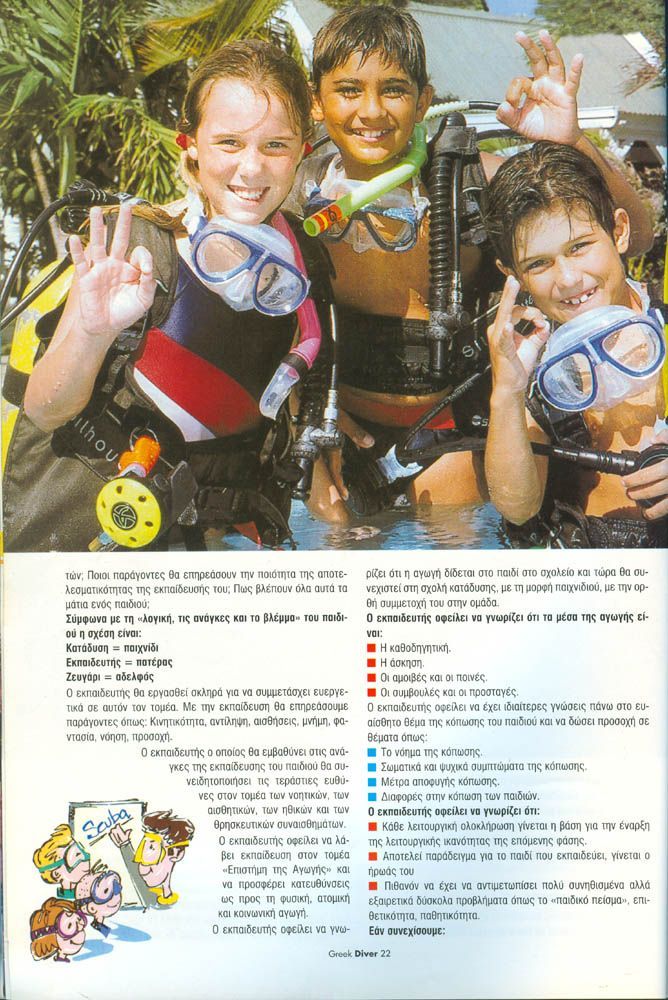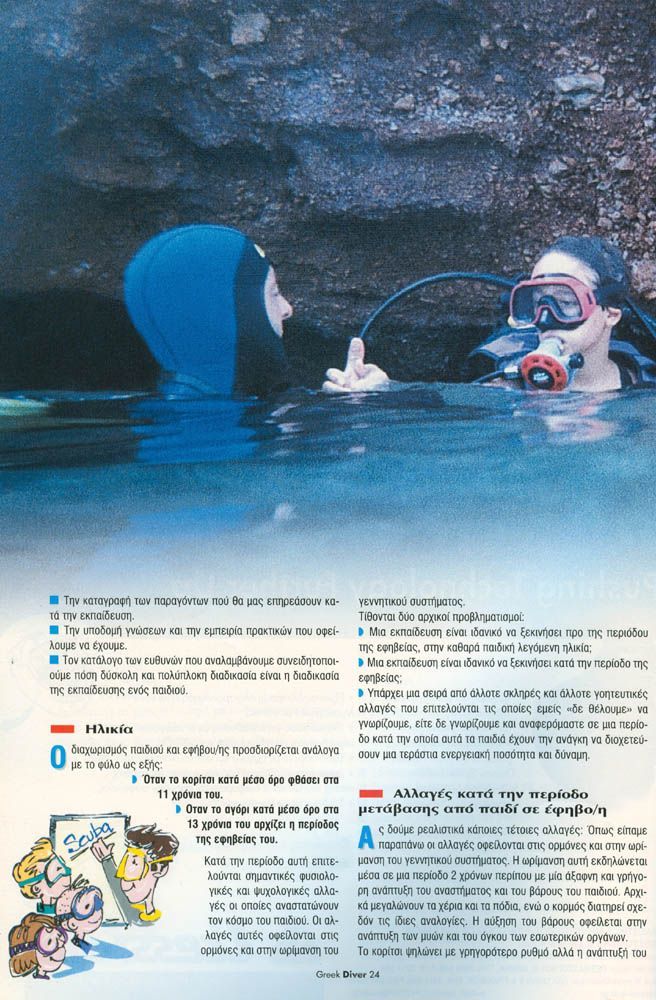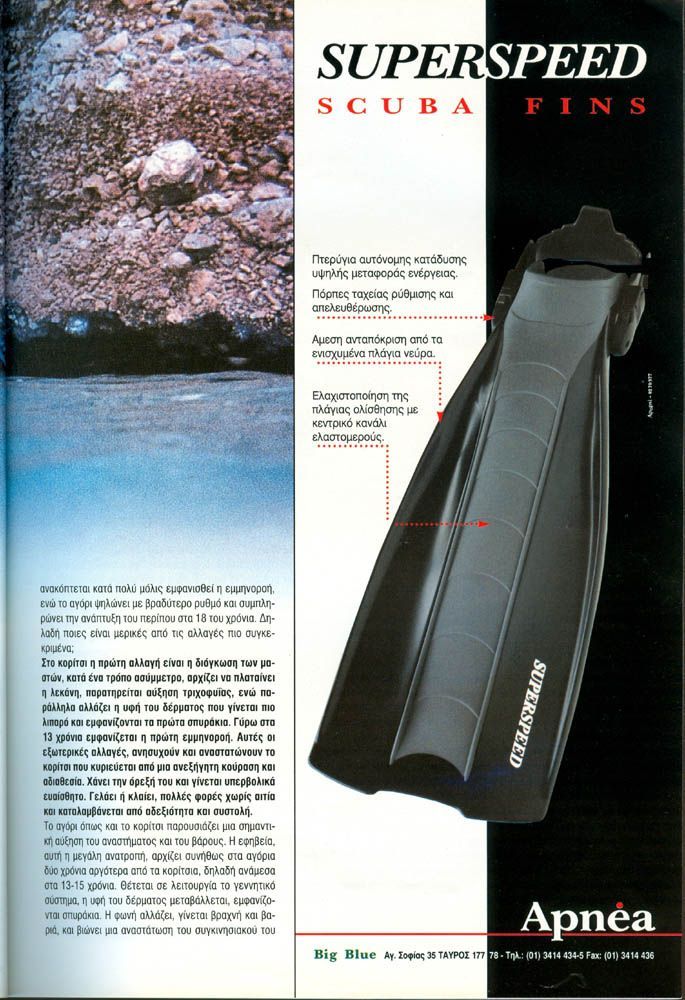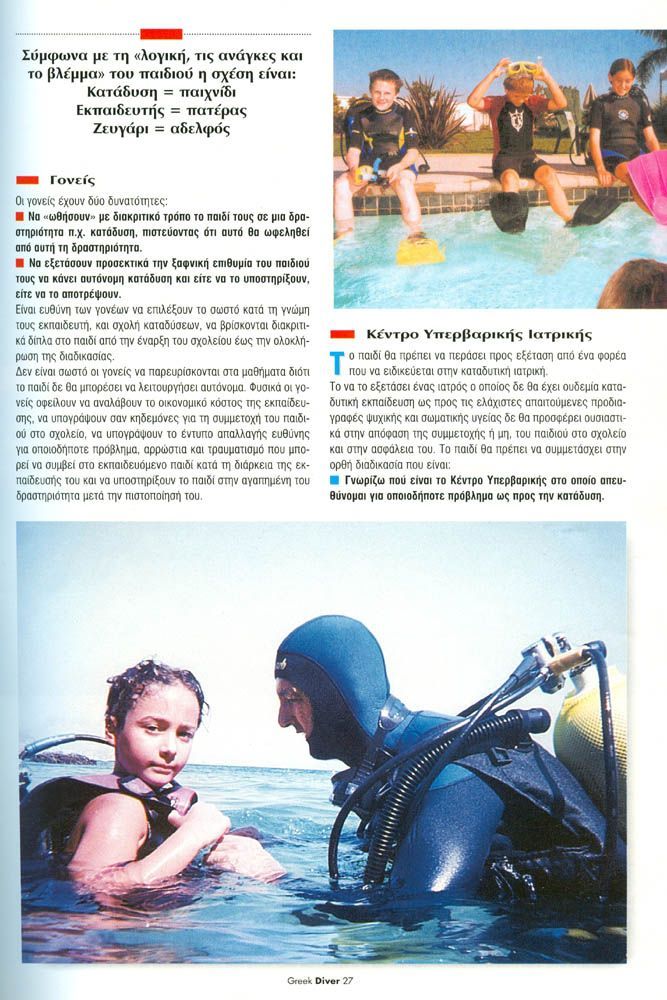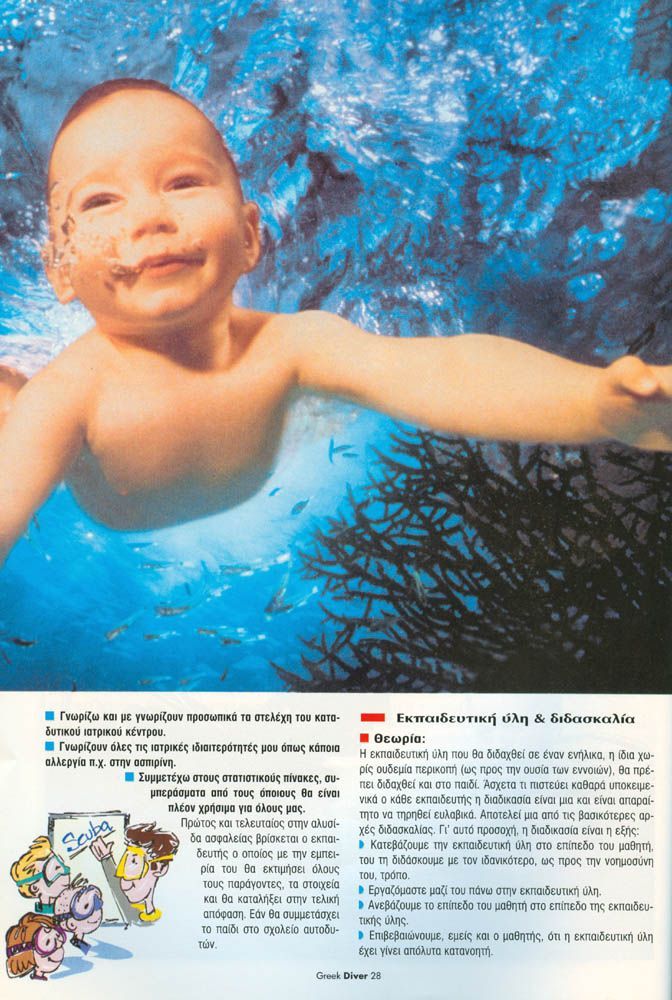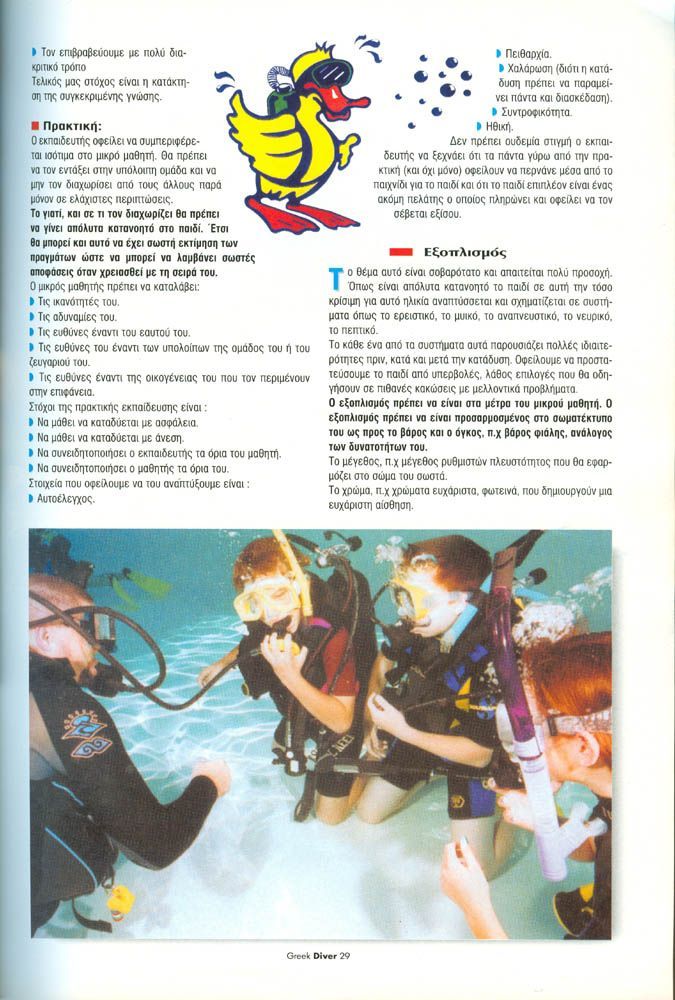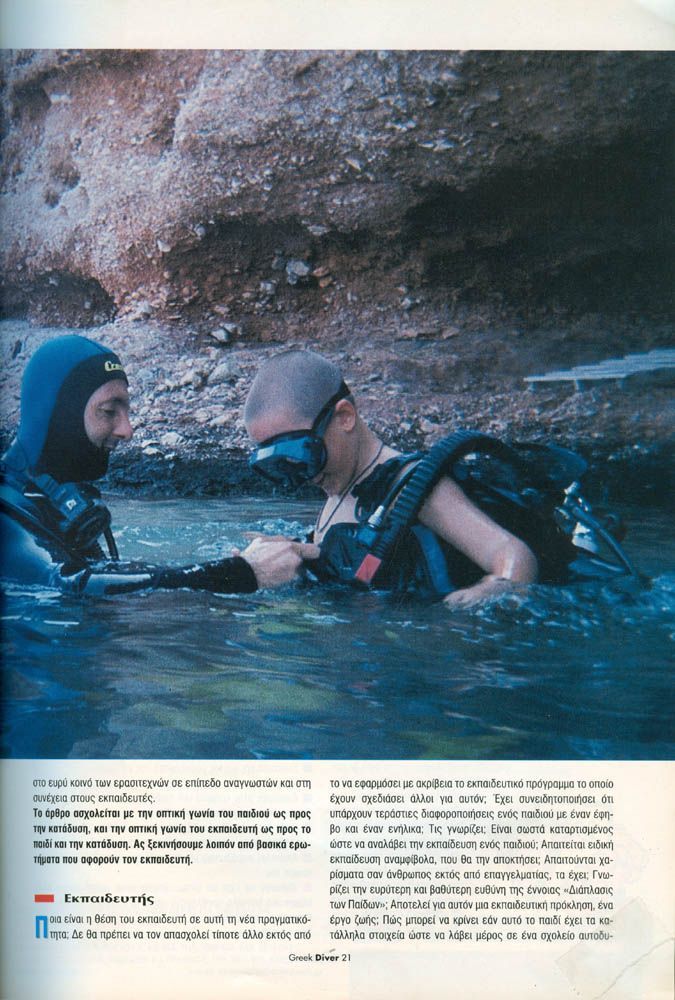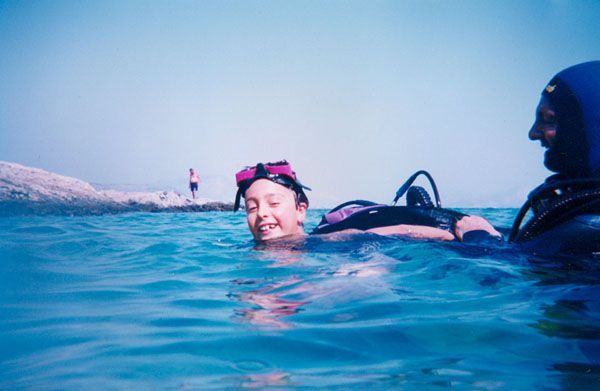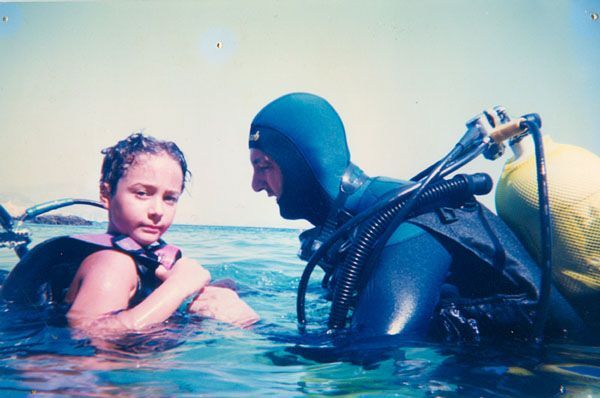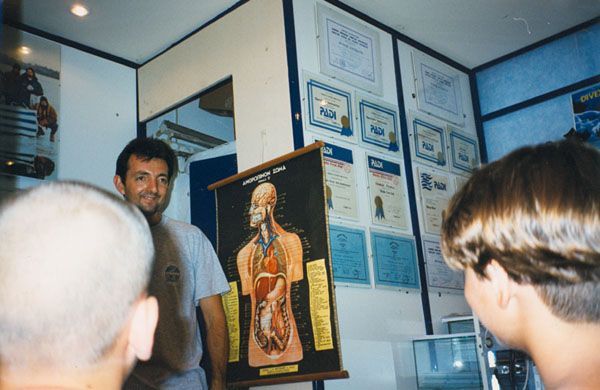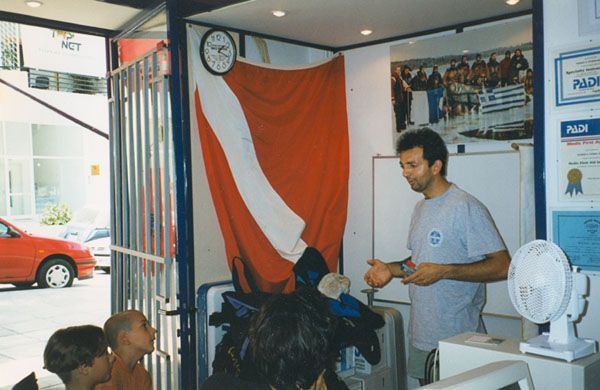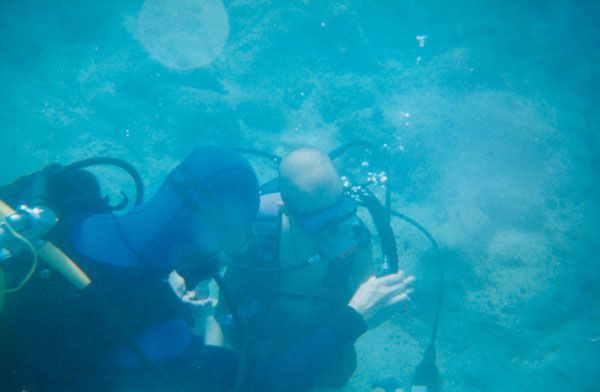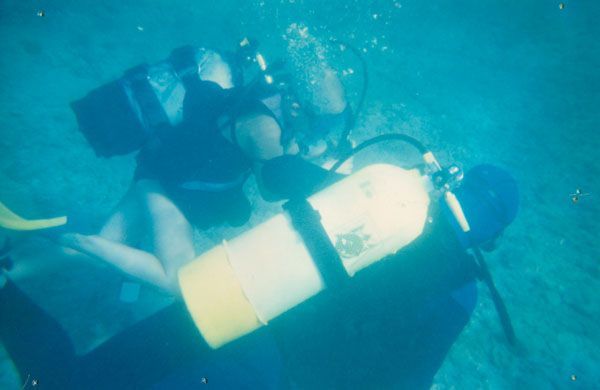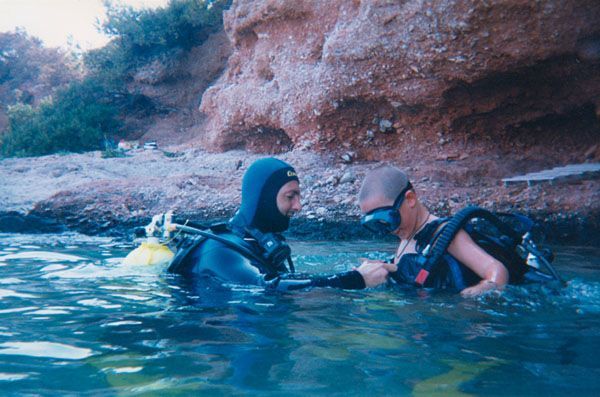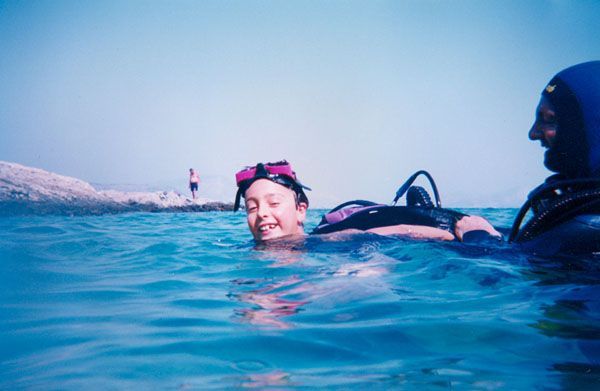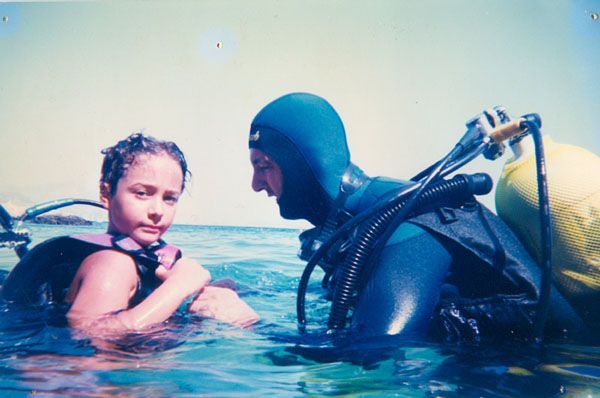Child & Diving
Columnist: George Petrou
Photos: Greek Diver & HUE Archive
"The fate of every people, its prosperity and decline, depend on the education its youth receive."
Πως βλέπει ένα παιδί την κατάδυση? Συναρπαστικά είναι η απάντηση.
Αλλά στα εσώψυχα του παιδιού οι συμβολισμοί είναι Κατάδυση - παιχνίδι, εκπαιδευτής - πατέρας, Ζευγάρι – αδελφός. Ο Εκπαιδευτής θα εργασθεί σκληρά στο να συμμετάσχει ευεργετικά σε αυτόν τον τομέα. Με την εκπαίδευση θα επηρεάσουμε παράγοντες όπως Ομαδικότητα, Κινητικότητα, Αντίληψη, Αισθήσεις, Μνήμη, Φαντασία, Νόηση, Συγκέντρωση.
Η καταδυτική δραστηριότητα κατά το μέγιστο ποσοστό θεωρείται και είναι προνόμιού απόλαυσης των ενηλίκων ανθρώπων. Τα τελευταία χρόνια η δημιουργία εκπαιδευτικών προγραμμάτων τα οποία έχουν σχεδιαστεί ειδικά για παιδιά, αναπτύσσονται ιδιαίτερα δυναμικά.
Ένας, ένας οι εκπαιδευτικοί οργανισμοί σχεδιάζουν τέτοια προγράμματα τα οποία επιτρέπουν σε ένα ή περισσότερα παιδιά μαζί να κάνουν αυτόνομη κατάδυση. Σκοπός και στόχος αυτού του άρθρου δεν είναι να παρουσιάσει τα προγράμματα και τους οργανισμούς που τα έχουν σχεδιάσει αλλά να δημιουργήσει μια "εργασία", να εκθέσει μια σειρά από σκέψεις και απόψεις του αρθρογράφου πάνω στο ιδιαίτερα ευαίσθητο αυτό θέμα.
This work presents a differentiation in relation to the articles which are mainly addressed, as usual, first of all to the general public of amateurs at the level of its readers, and then and simultaneously to the instructors.
The article deals with the child's perspective on diving, and the instructor's perspective on the child and diving. So let's start with basic questions concerning the instructor.
INSTRUCTOR
What is the position of the instructor in this new reality?
Shouldn't he be concerned with anything other than accurately implementing the training program that others have designed for him?
Has he realized that there are huge differences between a child, a teenager, and an adult? Is he aware of them?
Is he properly qualified to take on the education of a child? Special training is undoubtedly required, who will obtain it?
It requires human qualities in addition to being a professional, do you have them?
Is he aware of the broader and deeper responsibility of the concept of "Formation of Children"?
Αποτελεί για αυτόν μια εκπαιδευτική πρόκληση, ένα έργο ζωής?
Πώς μπορεί να κρίνει εάν αυτό το παιδί έχει τα κατάλληλα στοιχεία ώστε να λάβει μέρος σε ένα σχολείο αυτοδυτών?
Ποιοι παράγοντες θα επηρεάσουν την ποιότητα της αποτελεσματικότητας της εκπαίδευσής του?
How do a child's eyes see all this?
Σύμφωνα με την "λογική, τις ανάγκες και το βλέμμα" του παιδιού η σχέση είναι:
Κατάδυση = παιχνίδι
Εκπαιδευτής = πατέρας
Ζευγάρι = αδελφός
Ο Εκπαιδευτής θα εργασθεί σκληρά στο να συμμετάσχει ευεργετικά σε αυτόν τον τομέα. Με την εκπαίδευση θα επηρεάσουμε παράγοντες όπως:
Κινητικότητα
Perception
Senses
Memory
Φαντασία
Understanding
Attention
The Educator who will delve into the educational needs of the child will realize the enormous responsibilities in the field of:
Νοητικών συναισθημάτων
Feelings of elegance
Moral feelings
Religious feelings
The Educator must receive training in the field of "Educational Science" and provide guidance on:
Physical education
Individual treatment
Social education
The Instructor must know that the education is given to the child at school and will now continue at the diving school, in what way? Of course, through play!!! With his proper participation in the group.
The Instructor must know that the means of education are:
The guiding principle
The exercise
Rewards and penalties
The advice and the orders
The Educator must have special knowledge on the sensitive issue of child fatigue and pay attention to issues such as:
The meaning of fatigue
Physical and mental symptoms of fatigue
Measures to avoid fatigue
Διαφορές στην κόπωση των παιδιών
The Trainer must know that:
Each functional completion becomes the basis for the initiation of the functional capability of the next phase.
He sets an example for the child he educates, becomes his hero.
He/She may have to deal with very common but extremely difficult problems such as "childish stubbornness", aggression, passivity
If we continue:
- Την καταγραφή των παραγόντων πού θα μας επηρεάσουν κατά την εκπαίδευση
- Την υποδομή γνώσεων και εμπειρία πρακτικών που οφείλουμε να έχουμε
- Τον κατάλογο των ευθυνών που αναλαμβάνουμε
συνειδητοποιούμε πόση δύσκολη και πολύπλοκη διαδικασία είναι η διαδικασία της εκπαίδευσης ενός παιδιού. - Age
The separation of child and adolescent is determined according to gender as follows:
- When the average girl reaches 11 years of age
- Όταν το αγόρι κατά μέσο όρο στα 13 χρόνια του αρχίζει η περίοδος της εφηβείας του
During this period, significant physiological and psychological changes occur that disrupt the child's world. These changes are due to hormones and the maturation of the reproductive system.
Two initial concerns are raised:
- Is it ideal to start education before the period of adolescence, at the so-called purely childhood age?
- Μια εκπαίδευση είναι ιδανικό να ξεκινήσει κατά την περίοδο της εφηβείας?
- There are a series of sometimes harsh and sometimes charming changes that take place that we "don't want" to know about, or don't know about... and we are referring to a period during which these children need to channel an enormous amount of energy and strength.
Changes during the transition period from child to teenager
As we said above, the changes are due to hormones and the maturation of the reproductive system. This maturation manifests itself within a period of about 2 years with a sudden and rapid growth in the child's height and weight. Initially, the arms and legs grow, while the torso maintains almost the same proportions. The increase in weight is due to the development of muscles and the volume of the internal organs.
The girl grows taller at a faster rate but her growth is greatly halted once menstruation begins, while the boy grows taller at a slower rate and completes his growth at around 18 years of age. So what are some of the changes, more specifically? In the girl, the first change is the swelling of the breasts, in an asymmetrical way, the pelvis begins to widen, an increase in hair growth is observed, while at the same time the texture of the skin changes, becoming oilier and the first “nipples” appear. Around the age of 13, the first menstruation occurs. These external changes worry and upset the girl who is overcome by an inexplicable fatigue and malaise. She loses her appetite and becomes overly sensitive. She laughs or cries, often for no reason and is overcome by clumsiness and shyness.
Both boys and girls experience a significant increase in height and weight. Puberty, this major turning point, usually begins in boys two years later than in girls, that is, between the ages of 13 and 15. The reproductive system becomes functional, the texture of the skin changes, “pimples” appear. The voice changes, becomes hoarse and heavy, and the child experiences a disturbance in his emotional world that manifests itself in inexplicable fluctuations in joy or sadness, and in an awkwardness in his behavior. Hair grows, he increases in height and weight, his shoulders broaden and his muscles strengthen.
The boy and the girl need (we must develop it in them and even impose it on them) order and cleanliness, exercise and social activities. Sleep is essential for this critical age, as is rest, so they should not over-exert themselves with various sports events or excessive exercise. Special attention is required to their diet, ensuring a diet rich in proteins, vitamins and calcium, etc.
Game
Toys are the wonderful microcosm of children, with their own laws of "gravity, dimensions & perspectives". Within the large and inexplicable world of adults, the child feels that he is out of place and often maladjusted. The need for play is enormous and the age of children's play is their bridge, their passage into the world of adults. Until his bonds are stabilized and he is integrated into the world of adults, play is the child's companion. We cannot separate him from it. In order to be accepted in his world, we must play with him with his toys, or offer him other toys:
diving equipment, his own diving equipment
Through his games, the child uses and develops his various senses, satisfies the innate need for research, exercises his imagination, and his body, knows their capabilities. The mirror of the child's spiritual development is his speech, his movements, his choices, which reveal to us a part of his psyche. The child often has a slowness in speech which is due to psychological reasons created by the child's own environment.
Η ευθύνη της συμμετοχής ενός παιδιού σε Σχολείο Αυτόνομης κατάδυσης
There must be 100% agreement from the child to go diving. Not only should he agree, but he should want it very much. At no stage of diving should the child feel pressured or coerced. And this is where the talent, knowledge and capabilities of the instructor are shown. He should be accepted by the child.
Γονείς
Parents have two options:
To subtly "push" their child into an activity, such as diving, believing that they will benefit from this activity
to carefully consider their child's sudden desire to scuba dive and either support or discourage it.
Είναι ευθύνη των γονέων να επιλέξουν το σωστό κατά την γνώμη τους εκπαιδευτή, και σχολή καταδύσεων, να ευρίσκονται διακριτικά δίπλα στο παιδί από την έναρξη του σχολείου έως την ολοκλήρωσή της διαδικασίας. Δεν είναι σωστό οι γονείς να παρευρίσκονται στα μαθήματα διότι το παιδί δεν θα μπορέσει να λειτουργήσει αυτόνομα.
Of course, parents must take responsibility for:
- the financial cost of education
- the responsibility to sign as guardians for the child's participation in school
- the responsibility of signing the release form for any problem, illness and injury that occurs to the child during their education
- Support for the child to continue their favorite activity after certification.
Hyperbaric Medicine Center
- The child should be examined by a body specializing in Diving Medicine.
- Το να το εξετάσει ένας ιατρός ο οποίος δεν θα έχει ουδεμία καταδυτική εκπαίδευση ως προς τις ελάχιστες απαιτούμενες προδιαγραφές ψυχικής και σωματικής υγείας δεν θα προσφέρει ουσιαστικά στην απόφαση της συμμετοχής ή μη, του παιδιού στο σχολείο και στην ασφάλεια του.
Το παιδί θα πρέπει να συμμετάσχει στην ορθή διαδικασία πού είναι:
- Γνωρίζω πού είναι το Κέντρο Υπερβαρικής στο οποίο απευθύνομαι για οποιοδήποτε πρόβλημα ως προς την κατάδυση
- To know and be known personally by the diving medical center staff
- To know all my medical conditions, such as any allergies, e.g. to aspirin
- To participate in the statistical tables, conclusions from which will now be useful for all of us
The Trainer
First & Last in the safety chain is the instructor who, with his experience, will assess all the factors, the elements, and will reach the final decision. Whether the child will participate in scuba diving school.
Material & Teaching
Theory
The educational material that will be taught to an adult, the same without any cuts (as to the essence of the concepts), should also be taught to the child. Regardless of what each educator believes purely subjectively, the process is one and it is necessary to observe it reverently. It constitutes one of the most basic principles of teaching.
Για αυτό προσοχή, η διαδικασία είναι η εξής:
We bring the educational material down to the student's level, teaching it in the most ideal way, in terms of his intelligence.
We are working with him on the educational material.
We raise the student's level to the level of the educational material
Επιβεβαιώνουμε, εμείς και ο μαθητής, ότι η εκπαιδευτική ύλη έχει γίνει απόλυτα κατανοητή
We reward him in a very discreet way. Our ultimate goal is the acquisition of specific knowledge.
Practical Training
The instructor must treat the young student equally. He should integrate him into the rest of the group and not separate him from the others except in very few cases. The reason and what separates him should be made completely understandable to the child. This way, he will be able to have a correct assessment of things so that he can make the right decisions when needed in turn.
The young student must understand:
- Τις ικανότητές του
- His weaknesses
- Τις ευθύνες έναντι του εαυτού του
- His responsibilities towards the rest of his group or his partner
- The responsibilities towards his family that await him on the surface
The objectives of practical training are:
- Learn to dive safely
- Learn to dive with comfort
- Να συνειδητοποιήσει ο εκπαιδευτής τα όρια του μαθητή
- To make the student aware of his/her limits
Στοιχεία που οφείλουμε να του αναπτύξουμε είναι:
- Self-control
- Discipline
- Relaxation (because diving should always remain fun)
- Companionship
- Morality
The trainer must never forget that:
Τα πάντα γύρω από την πρακτική (και όχι μόνο) οφείλουν να περνάνε μέσα από το παιγνίδι για το παιδί
That the child is also another paying customer and must be respected equally
Equipment
Το θέμα αυτό είναι σοβαρότατο και απαιτείται πολύ προσοχή. Όπως είναι απόλυτα κατανοητό το παιδί σε αυτή την τόσο κρίσιμη για αυτό ηλικία αναπτύσσεται και σχηματίζεται σε συστήματα όπως:
- The heretical
- The muscular
- The respiratory
- The nervous
- The digestive system
Each of these systems presents many peculiarities before, during and after diving. We must protect the child from excesses, wrong choices that will lead to possible injuries with future problems.
The equipment must be tailored to the young student. The equipment must be adapted to his/her body type in terms of:
Το βάρος και ο όγκος, π.Χ. βάρος φιάλης ανάλογης των δυνατοτήτων του
The size, e.g. buoyancy regulator size that will fit his body properly
Το χρώμα, π.χ. χρώματα ευχάριστα, φωτεινά, που δημιουργούν μια ευχάριστη αίσθηση
Παραδείγματα από το εκπαιδευτικό πρόγραμμα Εκπαιδευτικού οργανισμού
So let's look at some of the children's training specifications from one of the largest amateur diving organizations, PADI.
Education of children aged 10-11 years
Maximum student to instructor ratio is 4 to 1
No more than two children aged 10-11 should be included in a group of four apprentice divers.
Maximum diving depth – 12 meters / -40 feet
Ονομασίες διπλωμάτων : Junior Scuba Diver και Junior Open Water Diver
Now PADI has also released the Bubble maker program
Site selection criteria should include: avoiding entrances/exits or other difficult conditions
Video: Youth Diving/Responsibility and Risks
The exams are only written and not oral. An exception is made in the case of someone who has some form of disability such as dyslexia.
Diving after certification
School is over and the child is proud of what he has achieved. The experience he has gained is unique, it differentiates him from other teenagers-children of his age. However, it is an equally critical period, as the period of diving school, but more relaxed. The child after school must dive often so that what he was taught during the education becomes completely his "property". He must be given the opportunity to enjoy his favorite occupation.
Πρέπει συνοδεία κάποιου έμπειρου αυτοδύτη ή εκπαιδευτή να καταδύεται σε:
- Easy points
- Spectacular points
- Teaching points
- Ελεγχόμενα σημεία
Epilogue
It goes without saying that this work is not intended and cannot play the role of a comprehensive manual but of an informative publication that offers foundations on the sensitive topic of "child and diving". The moral reward must be the greatest reward that the child's instructor will have received. He can feel proud that he put a small stone in a world of pleasure, physical and mental health. That he contributed to the education of this child. It is undoubtedly included in the top moments of the career of a scuba diving instructor.
Bibliography
- Pan. K. Sfika The Education of the Child Dr. F. Beer-Poitevin Child and Environment Ioannou K. Anagnostou Genetic Psychology Mich. Tsanis Behavioral Disorders of Children Sigmund Freud Introduction to Psychology
Hellas Underwater Explorers / George Petrou TDI/SDI/ERDI GREECE




